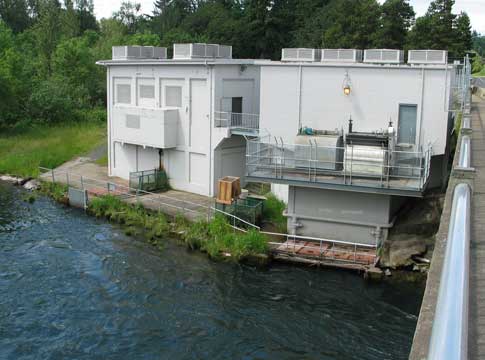Related News
Related News
-
EWEB Sets 2026 Budget and Rates, Advances Evaluation of McKenzie Valley Service Territory Realignment
Taken together, the 2026 budget and rate adjustments and the territory-realignment evaluation reflect EWEB’s dedication to responsible financial stewardship, modern, resilient utility infrastructure, and thoughtful planning for the future.
Find Out More -
Let's Talk Turkey. Is your family ready for winter?
We're heading into the holidays, but that also means snow, ice, and not-so-nice weather might be in the forecast. Here are some tips to prepare in advance.
Find Out More -
EWEB Hosts Annual Spill Drill to Protect McKenzie River
EWEB led emergency responders in its annual “spill drill” on the McKenzie River on Wednesday, Oct. 15, at the Trail Bridge Campground.
Find Out More -
A day in the life: Monitoring water quality throughout the McKenzie Watershed
Follow Senior Environmental Specialist David Donahue as he collects water quality samples from throughout the watershed as part of EWEB's early warning system for threats to Eugene's drinking water.
Find Out More -
EWEB Partners with Eugene School District 4J to Celebrate New Kennedy Middle School Emergency Water Station Site
Hundreds of attendees practiced filling up water containers at Saturday's demonstration event.
Find Out More -
Electric Projects underway in North & South Eugene
Underground lines and disaster-resilient power poles are part of EWEB’s infrastructure upgrade near Eugene’s largest natural resource area.
Find Out More -
Quartz Creek: Setting the Stage for Floodplain Restoration
The project resets the floodplain along 1.8 miles of a formerly channelized creek to improve water quality, fish habitat and natural disaster resiliency.
Find Out More -
Pure Water Partners: 5 Years of Regeneration
As EWEB and the Pure Water Partners observe the fifth anniversary of the Holiday Farm Fire, we celebrate major milestones in the watershed's recovery and check back in with PWP landowners who still have a lot of work ahead as they continue to rebuild their lives.
Find Out More -
Join the Pledge to Prepare
When you think about getting ready for an emergency, you probably have questions. You aren't alone. Preparing for emergencies can be overwhelming, which is why EWEB has put together a 12-month program to help you and your family get two weeks ready.
Find Out More -
You can’t predict the next disaster, but you can prepare
The earthquake lasted less than a minute. But now the power’s out. The tap runs dry. Cell service is spotty. Would you be ready?
Find Out More -
EWEB Celebrates Operators on the 75th Anniversary of the Hayden Bridge Filtration Plant
Learn more about the Water Treatment Plant Operators who have kept the Hayden Bridge Filtration Plant running for the last 75 years.
Find Out More -
NASA partners with EWEB to assess wildfire impacts to drinking water
NASA's Earth Information Center shares a new video detailing how EWEB's Drinking Water Source Protection work is advising new research tools
Find Out More -
EWEB prepares for wildfire season with risk mitigation measures
EWEB is building a more resilient electric system to weather various types of disasters, from wildfire to winter storms.
Find Out More -
EWEB environmental specialist wins prestigious awards for publication
Article recounting EWEB’s efforts to protect the McKenzie River after Holiday Farm Fire earns national recognition
Find Out More -
Last Call for EWEB/Lane County Septic Grants
Holiday Farm Fire recovery program now eligible for businesses, residential property owners who purchased post-fire, to cover inspection costs and new construction
Find Out More - Show More
Wildfire Impacts Bring Increased Water Monitoring
September 18, 2020

EWEB on Sept. 9 started an enhanced and comprehensive monitoring program of the source water pulled from the McKenzie River and the treated drinking water in response to the impacts of the Holiday Farm Fire.
The heightened monitoring for wildland fire byproducts includes fire suppression foam and the dry powered ammonium polyphosphate (fertilizer) used for aerial fire suppression. We are in communication with Fire Command to understand the types of materials being used to fight the fire.
Based on review of product chemical data sheets, any water quality impacts from use of these chemicals will essentially be in the category of surfactants (foam) or fertilizer (aerial suppression). To date, the chemicals used in fire suppression do not contain polyfluoroalkyl or perfluoroalkyl substances, otherwise known as PFAS. Click here to learn more about PFAS.
The foam is made from the same basic ingredients used in soap, shampoo and detergent and is effectively treated at the filtration plant. The powdered ammonium polyphosphate dropped from planes is similar to fertilizer, which the filtration plant can also effectively treat.
Results of this enhanced monitoring to date do not show impacts from fire suppression use, but as rains come and aerial use of the powder increases, this may change. Click here to view the latest monitoring results.
Our Hayden Bridge Filtration Plant treats and filters organic material, including dissolved organic carbon, fire suppression products and chemical contaminants, using the powdered active carbon (PAC) and rapid sand filtration systems. The PAC system works by adsorbing (attracting like a magnet) these organic material compounds to the carbon molecules. Once adsorbed to the PAC, the compounds are removed by the filtration process.
The monitoring also includes other chemical contaminants that could enter the watershed such as materials from burned structures and vehicles. Such chemicals are effectively treated using the PAC system followed by filtration. Materials like fuels would likely volatilize during the fire, and any such substances remaining would volatilize as they traveled down the river.
If any of this heightened monitoring shows any breakthrough of contaminants from the PAC system or filtration process at levels of public health concern, EWEB will notify our customers as soon as possible.
We continue to monitor both the source water and treated drinking water to ensure its safety. Public health is our top priority as we strive to meet the expectations for reliable service to our community's homes and businesses.

